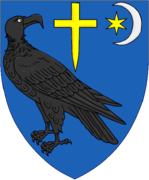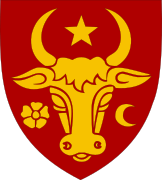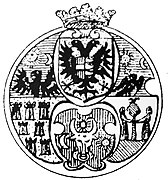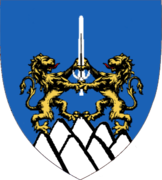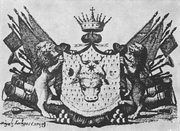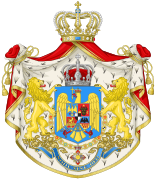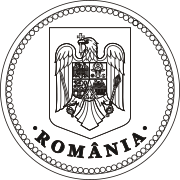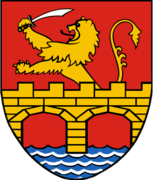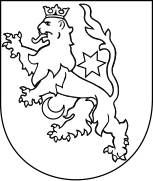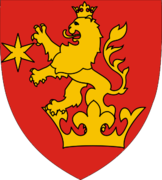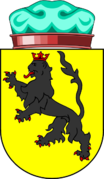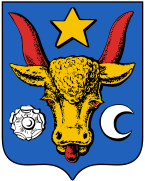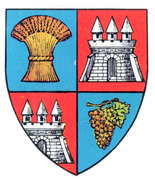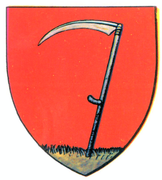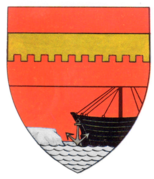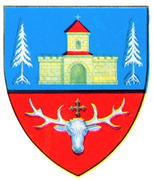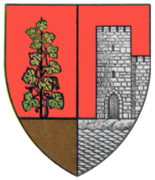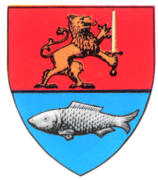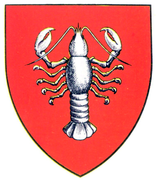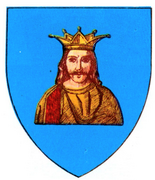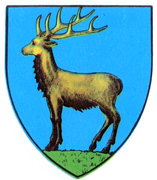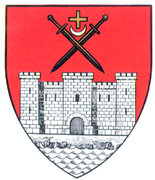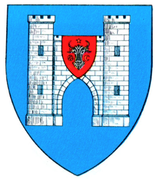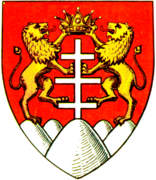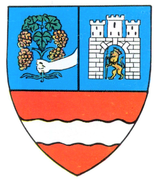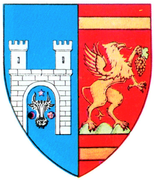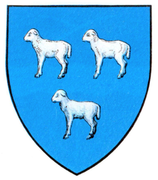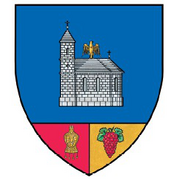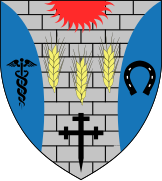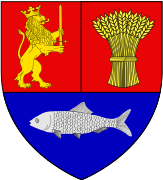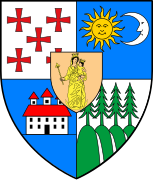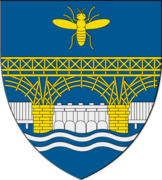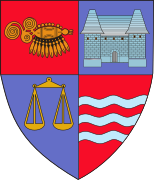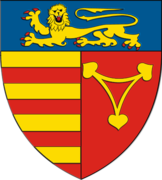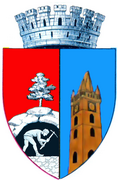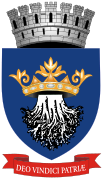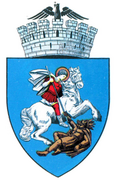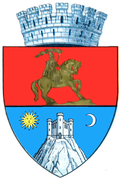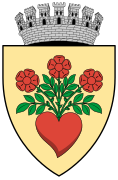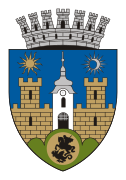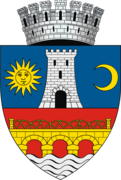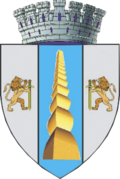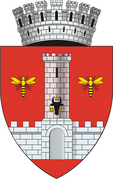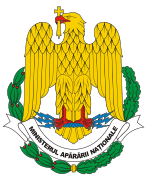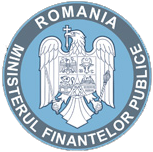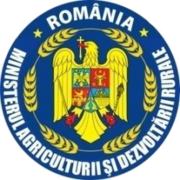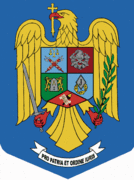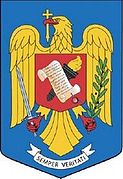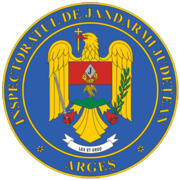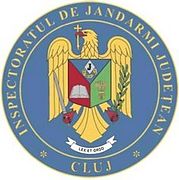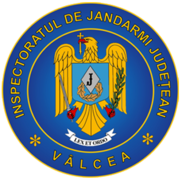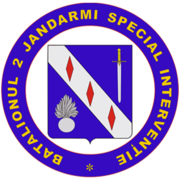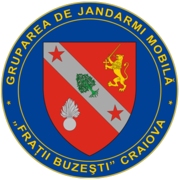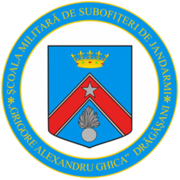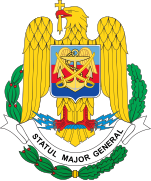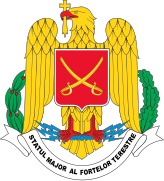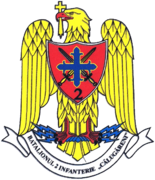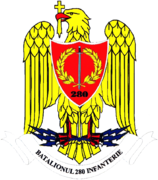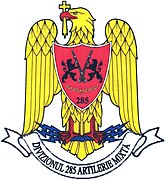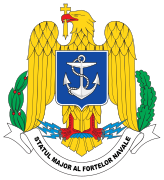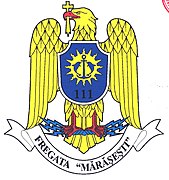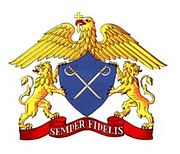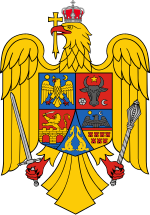Armorial of Romania
This article possibly contains original research. (August 2015) |
| This article is part of a series on |
| Symbols of Romania |
|---|
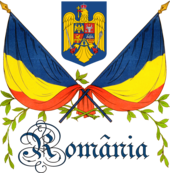 |
The
Romanian coats of arms
-
Arms of the King of Vlachs from the Portuguese Livro do Armeiro-Mor. (Perhaps from the Second Bulgarian Empire).
-
Arms ofMircea I of Wallachia (from a personal seal.) (The lion was used by many rulers of the House of Basarab)
Medieval States
-
Reproduction of Wallachia coat of arms in Middle Ages
-
Reproduction of Moldavia coat of arms in Middle Ages
-
Coat of Arms of the House of Basarab, founding dynasty of Wallachia
Coat of Arms during the Early Modern Period
The coats of arms of the early modern period represent the states of Romania from about the 15th century to about the 19th century.
-
Coat of arms of Wallachia, 1557 from the seal of Pătrașcu cel Bun.
-
Coat of arms of Wallachia 1587, from the seal of Mihnea Vodă Turcitul.
-
Coat of arms of Sigismund Bathory, suzerain of Transylvania at the time.
-
Coat of arms of prince Mihai Patraşcu (Michael the Brave), as lord of the first Romanian union between Moldova, Transylvania, and Wallachia, called the Dacian Principalities
-
Coat of arms of Transylvania, underKingdom of Dacia, (or the dynasty of Wallachia), and the seven hills representing the seven cities of the Transylvanian Saxons.
-
Coat of arms of Moldova, 1646
-
Coat of arms of Wallachia, 1691
-
Coat of arms of Wallachia, 1765
-
Coat of arms of Moldova, 1816
-
Coat of arms of Ardeal (Transylvania), proposed in 1848 by Romanian revolutionaries.
-
Coat of arms of Wallachia, 1851
States of the modern period
The United Principalities of Moldavia and Wallachia 1859–1866
After the election of
Romania 1866–1878
After 10 May 1866, (when Carol I came to Romania), and the Constitution of 1 June 1866 was founded, the coat of arms of Romania was established. It used concepts found in previous coats of arms. From 1872, the coat of arms represented the Kingdom of Romania. In 1878, when Romania gained independence, the coat of arms was changed again.
Kingdom of Romania
1872–1921
In 1872, the heraldic symbols of
-
1872-1881
-
1881-1921
1921–1947
After World War I, Transylvania, Bessarabia, Banat, and Bukovina united with the Kingdom of Romania. As a result, symbols representing the new territories were added to the coat of arms.
-
Royal House and Ministry of Foreign Affairs
-
Ministry of War)
-
Romanian small coat of arms (for all other seals)
Communist Romania
People's Republic of Romania
After 1948, the
-
January–March 1948
-
March 1948–1952
-
1952–1966
Socialist Republic of Romania
The final change to the communist emblem took place in 1966 when Romania ceased to be a People's Republic, and became a Socialist Republic. At this time, the wording changed from R. P. R. to Republica Socialista Romania.
Romania
1989–1992
Immediately after the fall of
During this period, Romania had no de jure national emblem. 10-lei coins issued in this period bore a composition showing a wreath of olive overlaid on the Romanian Flag where the coat of arms would be located on later coins.
1992–present
In 1992, the Parliament of Romania adopted a new coat of arms. Two models, both inspired by the coat of arms of the Kingdom of Romania, were merged to achieve the final result.
In April 2016, deputies of the Judiciary Committee endorsed a bill voted previously by the
-
The current coat of arms
-
Theseal
-
Coat of arms of Romania (1992–2016)
Historic Romanian regions and provinces
Marmatia
Crisana
Banat Region
-
The bridge of Apollodorus of Damascus on the Danube, the coat of arms of Banat 1918–1947.
Transylvania
-
Coat of arms of Transylvania, underMichel the Brave
-
Unofficial Romanian arms of Crișana
-
Cezar Bolliac redesign of the arms of Transylvania
-
Arms endorsed by Romanian nationalists in 1840s
Wallachian Region
In the Middle Ages, Wallachia had two core provinces. One was Greater Wallachia (Muntenia) and the other was Lesser Walachia (Oltenia). There was also the disputed province of Dobruja. These provinces were mostly geographical, not administrative, but from the end of the 15th century, because the Banate of Severin was partitioned between Wallachia and the Kingdom of Hungary, Oltenia was ruled by a ban. Oltenia was known as the Banate of Craiova. It is unknown whether the Despotate of Dobruja originally had a coat of arms. Control of the region over time involved Romania, Bulgaria and the Ottoman Empire. The present coat of arms of Dobruja was created in 1872. Also in 1872, a new form of the Wallachia coat of arms was officiated to represent just Muntenia. In the Middle Ages, Muntenia had had a different heraldic symbol.
-
Coat of arms of Oltenia in the Middle Ages
-
Coat of arms of Oltenia from 1872
-
Coat of arms of Southern Bessarabia (1871–1878) and Dobruja (from 1878)
-
Coat of arms of Muntenia in the Middle Ages
-
Coat of arms of Muntenia from 1872
Moldovan Region
In the Middle Ages,
-
Coat of arms of Moldavia
-
Coat of arms of Bukovina
-
Coat of arms ofBasarabia
Coats of arms of local authorities
Coats of arms of the counties in the interwar period (1926–1938 and 1940–1947)
Coats of arms of the ținuturi (lands) between 1938 and 1940
-
Ținutul Crișuri (Ținutul Someș)
-
Ținutul Dunării (Ținutul Dunărea de Jos)
Coats of arms of the counties
Coats of arms of the county seats
The coats of arms of the county seats are distinguished from those of the urban entities by the absence of a mural crown present in the latter. The crown has an odd number of towers (one, three, five or seven), depending on the importance of the urban entity.
-
Alba-Iulia
-
Alexandria
-
Arad
-
Bacău
-
Baia Mare
-
Botoșani
-
Brașov
-
Brăila
-
Buftea
-
Buzău
-
Călărași
-
Constanța
-
Craiova
-
Focșani
-
Galați
-
Giurgiu
-
Iași
-
Miercurea-Ciuc
-
Oradea
-
Piatra Neamț
-
Pitești
-
Râmnicu Vâlcea
-
Reșița
-
Satu Mare
-
Sfântu Gheorghe
-
Sibiu
-
Slatina
-
Suceava
-
Târgoviște
-
Târgu Jiu
-
Târgu Mureş
-
Tulcea
-
Vaslui
-
Zalău
Coats of arms of central institutions
Parliament
The
-
Chamber of Deputies of Romania
-
Senate of Romania (1992 (?) – 2016)
-
Chamber of Deputies of Romania(1992 (?) – 2016)
Ministries
-
Ministry of Justice
-
Ministry of Defense
-
Coat of arms of the Ministry of Administration and Interior
-
Ministry of Environment and Forests
-
Ministry of Agriculture and Rural Development
Former coats of arms
-
FormerMinistry of European Integration of Romania
-
The coat of arms of theMinistry of Justiceused until 2007
-
The coat of arms of TheMinistry of Administration and Interiorused until about 2008
Heraldry of the Ministry of Administration and Interior
In 2008, the
-
Romanian National Archives
Police heraldry
Gendarmerie heraldry
-
Argeș County Gendarmerie Inspectorate
-
Botoșani County Gendarmerie Inspectorate
-
Brăila County Gendarmerie Inspectorate
-
Cluj County Gendarmerie Inspectorate
-
Constanța County Gendarmerie Inspectorate
-
Galați County Gendarmerie Inspectorate
-
Hunedoara County Gendarmerie Inspectorate
-
Maramureș County Gendarmerie Inspectorate
-
Mehedinți County Gendarmerie Inspectorate
-
Olt County Gendarmerie Inspectorate
-
Prahova County Gendarmerie Inspectorate
-
Satu Mare County Gendarmerie Inspectorate
-
Vâlcea County Gendarmerie Inspectorate
-
Special Gendarmes Battalion 1 Antiterrorism Intervention and Special Actions
-
Special Gendarmes Battalion no. 2 Intervention
-
Centre for Gendarmes Employees Training Gheorgheni
-
Centre for Gendarmes Employees TrainingOchiuri
-
Sinaia Mountain Centre
-
Bucharest General Directorate for Gendarmes
-
Gendarmerie Mobile Group "Frații Buzești" Craiova
-
Gendarmerie Mobile Group "Matei Basarab" Ploiești
-
Gendarmerie Mobile Group "Tomis" Constanța
-
"GendarmerieOfficers
-
"Gendarmerie Under-Officers Drăgășani
-
Military School forGendarmerie Under-Officers Fălticeni
-
Special Unit 76 Gendarmes Guard and Protection for Financial Institutions and Banks
Other law enforcement authorities
-
Romanian Financial Guard
Heraldry of the Romanian Armed Forces
Since the 18th century, the symbol of the
-
The main heraldic element of theRomanian Army
-
Minister of National Defense
-
30th Honor Guard Regiment "Mihai Viteazul"
-
2nd Infantry Battalion "Călugăreni" ("Desert Tigers")
-
280th Mechanized Infantry Battalion
-
285th Mixed Artillery Battalion "Vlaicu Vodă"
-
288th Anti-aircraft Artillery Battalion
-
8th Mixed Artillery Brigade "Alexandru Ioan Cuza"
-
82nd Anti-Tank Artillery Battalion "General Alexandru Tell"
-
83rd Multiple Rocket Launcher Battalion "Bogdan I"
-
84th Data Acquisition Battalion "Mărăști"
-
85th Logistics Battalion "General Mihail Cerchez"
-
96th Multiple Rocket Launcher Battalion "Mircea Voievod"
-
Regele Ferdinand
-
Regina Maria
Secret services
-
Romanian Intelligence Service
-
Foreign Intelligence Service
-
Protection and Guard Service
-
Special Telecommunication Service
See also
References
- ^ "Senatul a aprobat modificarea stemei Romaniei. Cum va arata noul simbol" (in Romanian). Pro TV. 16 February 2016. Retrieved 27 April 2016.
- ^ Cătălina Mănoiu (19 April 2016). "Data până la care trebuie readusă coroana pe stema ţării". Gândul.
- ^ "Camera Deputaţilor a adoptat proiectul care modifică stema ţării". Mediafax (in Romanian). 8 June 2016. Retrieved 8 June 2016.
- ^ "Coroana revine pe stema României. Iohannis a promulgat legea care modifică însemnele oficiale – FOTO" (in Romanian). Mediafax. 11 July 2016. Retrieved 11 July 2016.



